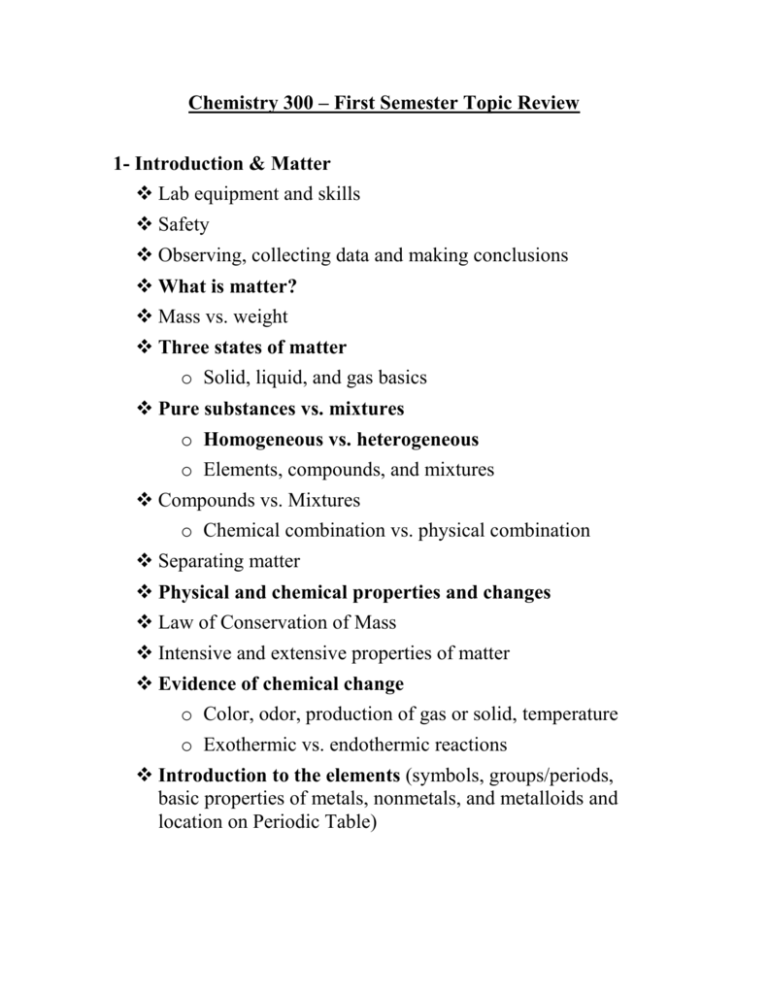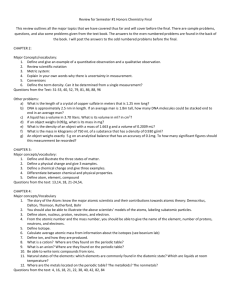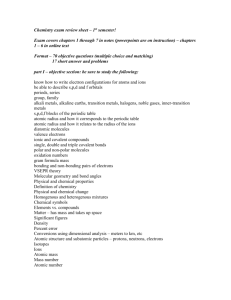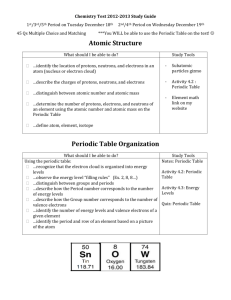Midterm Topic Review 300
advertisement

Chemistry 300 – First Semester Topic Review 1- Introduction & Matter Lab equipment and skills Safety Observing, collecting data and making conclusions What is matter? Mass vs. weight Three states of matter o Solid, liquid, and gas basics Pure substances vs. mixtures o Homogeneous vs. heterogeneous o Elements, compounds, and mixtures Compounds vs. Mixtures o Chemical combination vs. physical combination Separating matter Physical and chemical properties and changes Law of Conservation of Mass Intensive and extensive properties of matter Evidence of chemical change o Color, odor, production of gas or solid, temperature o Exothermic vs. endothermic reactions Introduction to the elements (symbols, groups/periods, basic properties of metals, nonmetals, and metalloids and location on Periodic Table) 2 - Measurement & Methods Scientific Method o Hypothesis, etc. o Qualitative vs quantitative data o Variables – independent, dependent and controlled Measurements Graphing techniques Scientific Notation SI Units (metric prefixes) Significant Figures – (multiplication/division rules only) Temperature scales (converting between Celsius and Kelvin) Mass, volume, and density Uncertainty in measurement o Accuracy vs. precision o Percent error (experimental value – accepted value)/(accepted value) x 100 3 - Atomic Structure History of development of models (Democritus, Dalton, Thomson, Rutherford, Bohr) Structure of the atom Symbol, mass, charge and location for proton, neutron, and electron Atomic number, atomic mass, mass number Determining number of protons, neutrons, and electrons for atoms and ions Isotopes and weighted average atomic mass Ions – cations and anions and symbols 4 - Atomic Theory Basics of electromagnetic waves (light) o Relationship between color of light and its energy o Dual nature of light (waves and particles) Atomic emission spectra Bohr model of the atom o Concept of ground and excited states for electrons Quantum mechanical model o Heisenberg’s Uncertainty Principle and Schrodinger o Atomic Orbitals vs. Orbits Electron configurations, orbital diagrams and noble gas configurations Hund’s Rule, Pauli Exclusion Principal and Aufbau Principle Isoelectronic species and ion formation Lewis Dot Diagrams Periodic Table Periodic Table development: Mendeleev and Moseley Periodic Table: groups (family names), blocks, series, etc. Metals vs. nonmetals vs. metalloids o Similarities and differences of chemical and physical properties within and between groups. Periodic Table Trends: atomic radius, ionization energy, electronegativity o Net nuclear charge, shielding and shells Concept of valence electrons, Lewis dot structures for atoms, and unpaired electrons and the Octet Rule. 6 - Ionic Compounds Bonds o Attractive forces (chemical bonds all based on attraction of protons and electrons) o Types of bonding determines types of compounds: Ionic vs. covalent bonds (what happens to electrons?) Ionic compounds vs. molecules (which types of elements are involved?) o Bond forming (energy released) and breaking (energy must be absorbed). Exothermic vs. endothermic Ionic Compounds o Creation by transfer of electrons from metals to nonmetals forming cations and anions o Crystal lattices are strong structures o Ionic compound properties Formula writing and naming for ions, ionic compounds and diatomic elements o Likely charges (based on valence electrons & group). o Stock system and Latin naming for transition metals. o Polyatomic ions o Cross-over rule Balancing chemical equations using coefficients 5 types of reactions (synthesis, decomposition, combustion, single replacement, double replacement) Writing out symbolic equations given words Predicting products of reactions Activity Series - for Single Replacement Reactions 7 - Dimensional Analysis and the Mole Methodology for converting between units and problem solving Memorize SI unit prefixes and base units. “Railroad Track” approach – let the units show the way! Mole concept and conversions (mass, moles, molecules, atoms). Avogadro’s number (6.022 x 1023) Molar mass (gram formula mass) Converting between: grams moles molecules atoms or ions Percent composition 8 - Stoichiometry Empirical and molecular formulas Stoichiometry (using mole ratios from balanced reactions) o Calculate of quantities of reactants and products in chemical reactions using molar relationships Limiting reactants Percent yield Note: It will help you greatly if you have the following items solidly implanted in your brain: the chemical symbols of the elements, charges based on locations on the Periodic Table, how to name all types of ions, polyatomic ion names and formulas (“Nick the Camel…”, how to recognize and name and write formulas for ionic compound, metric prefixes for unit conversions, Avogadro’s number, how to recognize the 5 different types of reactions, the periodic trends (for shielding, shells, net nuclear charge, atomic radius, ionization energy, and electronegativity) and why they occur, the diagonal spdf pattern for determining electron configurations, any important equations/formulas (ex: density, converting Celsius to Kelvin, etc.), how to recognize atomic number and atomic mass on ANY Periodic Table… just a few suggestions.





